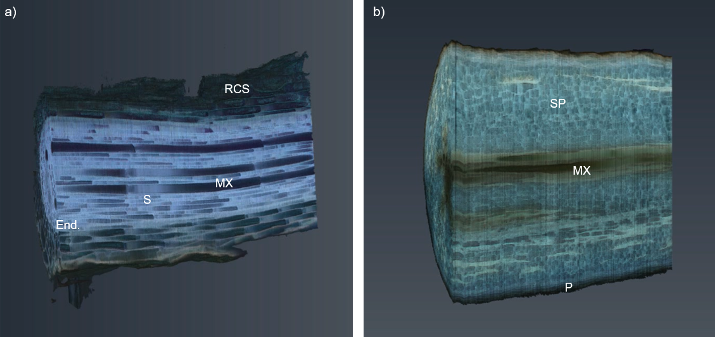
Root and xylem anatomy in wheatgrass
Authors
Clement C, HM Schneider, DB Dresbøll, JP Lynch, K Thorup-Kristensen
Source
Annals of Botany, in press
Download Options
Abstract
Background & Aims
Deep roots (i.e. > 1 m depth) are important for crops to access water when the topsoil is dry. Root anatomy and hydraulic conductance play important roles for the uptake of soil water, particularly water located deep in the soil. We investigated whether root and xylem anatomy vary as a function of root type, order and length or with soil depth in roots of intermediate wheatgrass, Thinopyrum intermedium (Kernza®), and alfalfa, Medicago sativa, two deep-rooted perennial crops. We linked the influence of these anatomical traits to the plant capacity to take up water from deep soil layers.
Methods
Using laser ablation tomography, we compared the roots of the two crops for cortical area, number and size of metaxylem vessels and their Estimated Root Axial Hydraulic Conductance (ERAHCe). The deepest roots investigated were located at soil depths of 2.25 and at 3.5 m in the field and in rhizoboxes, respectively. Anatomical differences were characterized along 1-m long individual roots, among root types and orders as well as between environmental conditions.
Key Results
For both crops, a decrease in the number, diameter, or both, of metaxylem vessels along individual root segments and with soil depth in the field resulted in a decrease in ERAHCe. Alfalfa, with a higher number of metaxylem vessels throughout the soil profile and, on average, a 4-fold higher ERAHCe, took up more water from the deep soil layers than intermediate wheatgrass. Root anatomical traits were significantly different across root types, classes and growth conditions.
Conclusions
Root anatomical traits are important tools for the selection of crops with enhanced exploitation of deep water. The development and breeding of perennial crops for improved subsoil exploitation will be aided by greater understanding of root phenotypes linked to deep root growth and activity.

